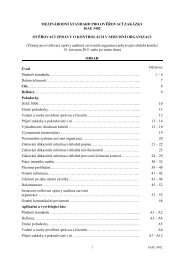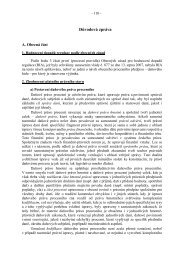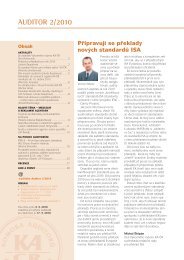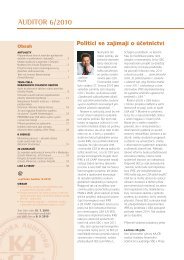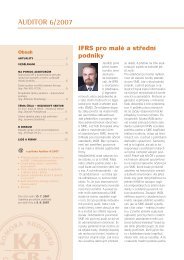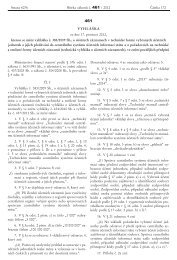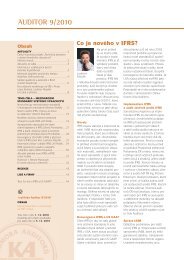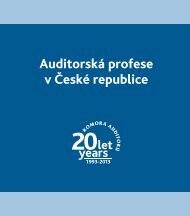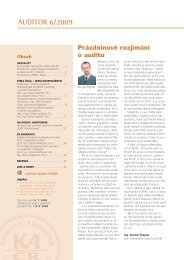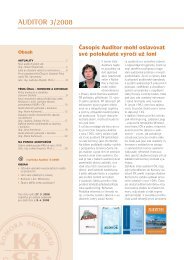Guide to Using International Standards on Auditing in - IFAC
Guide to Using International Standards on Auditing in - IFAC
Guide to Using International Standards on Auditing in - IFAC
Create successful ePaper yourself
Turn your PDF publications into a flip-book with our unique Google optimized e-Paper software.
36<br />
<str<strong>on</strong>g>Guide</str<strong>on</strong>g> <str<strong>on</strong>g>to</str<strong>on</strong>g> <str<strong>on</strong>g>Us<strong>in</strong>g</str<strong>on</strong>g> <str<strong>on</strong>g>Internati<strong>on</strong>al</str<strong>on</strong>g> <str<strong>on</strong>g>Standards</str<strong>on</strong>g> <strong>on</strong> <strong>Audit<strong>in</strong>g</strong> <strong>in</strong> the Audits of Small- and Medium-Sized Entities Volume 1—Core C<strong>on</strong>cepts<br />
• The appropriate exercise of professi<strong>on</strong>al judgment is essential <strong>in</strong> tailor<strong>in</strong>g the procedures <str<strong>on</strong>g>to</str<strong>on</strong>g> resp<strong>on</strong>d<br />
appropriately <str<strong>on</strong>g>to</str<strong>on</strong>g> the assessed risks; and<br />
• Professi<strong>on</strong>al judgment cannot be used <str<strong>on</strong>g>to</str<strong>on</strong>g> avoid compliance with any ISA requirements except <strong>in</strong><br />
excepti<strong>on</strong>al circumstances.<br />
In additi<strong>on</strong>, the ISAs c<strong>on</strong>ta<strong>in</strong> a number of special paragraphs that address c<strong>on</strong>siderati<strong>on</strong>s specific <str<strong>on</strong>g>to</str<strong>on</strong>g> audits of<br />
SMEs. This material provides useful guidance material <strong>in</strong> apply<strong>in</strong>g specific ISA requirements <strong>in</strong> the c<strong>on</strong>text of<br />
an SME audit.<br />
Some suggesti<strong>on</strong>s for successfully implement<strong>in</strong>g ISAs <strong>on</strong> smaller engagements are <strong>in</strong>cluded <strong>in</strong> the follow<strong>in</strong>g exhibit.<br />
Exhibit 3.6-1<br />
1. Take time <str<strong>on</strong>g>to</str<strong>on</strong>g> read the clarified ISAs and <str<strong>on</strong>g>to</str<strong>on</strong>g> tra<strong>in</strong> staff.<br />
Failure <str<strong>on</strong>g>to</str<strong>on</strong>g> understand the requirements can lead <str<strong>on</strong>g>to</str<strong>on</strong>g>:<br />
• The entire risk assessment phase of the audit becom<strong>in</strong>g an “add-<strong>on</strong>” <str<strong>on</strong>g>to</str<strong>on</strong>g> the other substantive audit<br />
work performed. It should be the risk assessment that drives the selecti<strong>on</strong> of audit procedures <str<strong>on</strong>g>to</str<strong>on</strong>g> be<br />
performed, not a standardized list<strong>in</strong>g of procedures that could be applied <str<strong>on</strong>g>to</str<strong>on</strong>g> any entity. The purpose<br />
of the risk assessment is <str<strong>on</strong>g>to</str<strong>on</strong>g> focus the audit effort <strong>on</strong> areas where there is a greater risk of material<br />
misstatement <strong>in</strong> the f<strong>in</strong>ancial statements, and away from less risky areas.<br />
• Turn<strong>in</strong>g what should be a simple audit <strong>in</strong><str<strong>on</strong>g>to</str<strong>on</strong>g> a complex and time-c<strong>on</strong>sum<strong>in</strong>g project. This can arise if<br />
efforts are focused <strong>on</strong> complet<strong>in</strong>g needless standard audit forms and checklists, rather than us<strong>in</strong>g<br />
professi<strong>on</strong>al judgment <str<strong>on</strong>g>to</str<strong>on</strong>g> scale the work accord<strong>in</strong>g <str<strong>on</strong>g>to</str<strong>on</strong>g> the size and complexity of the entity be<strong>in</strong>g<br />
audited and the risks <strong>in</strong>volved.<br />
• Failure <str<strong>on</strong>g>to</str<strong>on</strong>g> comply with an ISA (“the audi<str<strong>on</strong>g>to</str<strong>on</strong>g>r shall”) requirement.<br />
2. Take time <str<strong>on</strong>g>to</str<strong>on</strong>g> plan well, no matter how small the engagement.<br />
It has been said an hour spent <strong>in</strong> plann<strong>in</strong>g can save many more <strong>in</strong> executi<strong>on</strong>. Effective audit plann<strong>in</strong>g is often the<br />
difference between a quality audit with<strong>in</strong> budget and a poor-quality audit that goes over budget. This does not<br />
necessarily mean hold<strong>in</strong>g dedicated team meet<strong>in</strong>gs <strong>in</strong> the office. On very small engagements, plann<strong>in</strong>g can be<br />
achieved through brief discussi<strong>on</strong>s at the start of the engagement and as the audit progresses.<br />
Key areas <str<strong>on</strong>g>to</str<strong>on</strong>g> address <strong>in</strong> plann<strong>in</strong>g:<br />
• Encourage staff <str<strong>on</strong>g>to</str<strong>on</strong>g> identify areas where the usual audit procedures seem excessive <strong>in</strong> relati<strong>on</strong> <str<strong>on</strong>g>to</str<strong>on</strong>g> the<br />
risk of misstatement be<strong>in</strong>g addressed.<br />
• Take time <str<strong>on</strong>g>to</str<strong>on</strong>g> ensure that each staff member understands the necessity and purpose of the<br />
documentati<strong>on</strong> he or she is required <str<strong>on</strong>g>to</str<strong>on</strong>g> complete. Countless hours can be lost by staff attempt<strong>in</strong>g <str<strong>on</strong>g>to</str<strong>on</strong>g><br />
complete forms they do not understand.<br />
• Discuss the potential for fraud. Encourage staff <str<strong>on</strong>g>to</str<strong>on</strong>g> be skeptical and <strong>in</strong>quisitive, and empower them <str<strong>on</strong>g>to</str<strong>on</strong>g><br />
raise issues, observati<strong>on</strong>s, or unexpla<strong>in</strong>ed matters.<br />
• Discuss known related parties and the nature/size of transacti<strong>on</strong>s.<br />
• C<strong>on</strong>sider whether the audit documentati<strong>on</strong> prepared <strong>in</strong> previous periods can simply be updated for<br />
changes that have occurred, rather than be prepared all over aga<strong>in</strong>. Documentati<strong>on</strong> and assessment<br />
of risk fac<str<strong>on</strong>g>to</str<strong>on</strong>g>rs and relevant <strong>in</strong>ternal c<strong>on</strong>trols should be sufficient <str<strong>on</strong>g>to</str<strong>on</strong>g> enable audi<str<strong>on</strong>g>to</str<strong>on</strong>g>rs <strong>in</strong> subsequent<br />
periods <str<strong>on</strong>g>to</str<strong>on</strong>g> leverage their understand<strong>in</strong>g of the entity and focus attenti<strong>on</strong> <strong>on</strong> new <strong>in</strong>dustry trends, key<br />
operati<strong>on</strong>al changes, new <strong>in</strong>herent risks, and revised <strong>in</strong>ternal c<strong>on</strong>trols.




